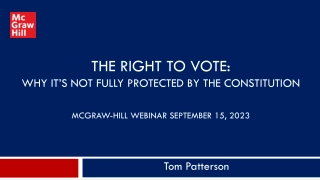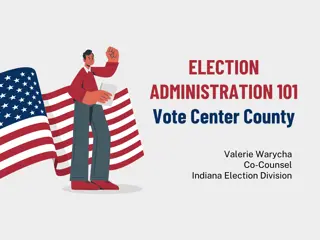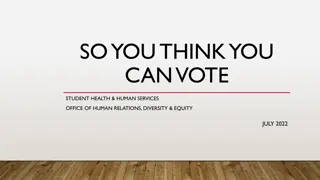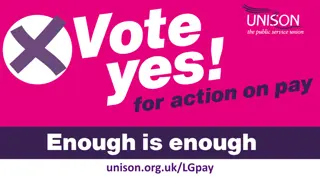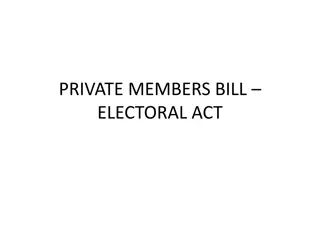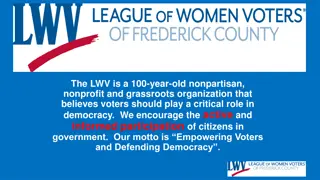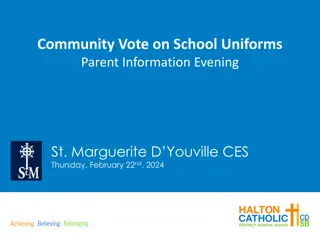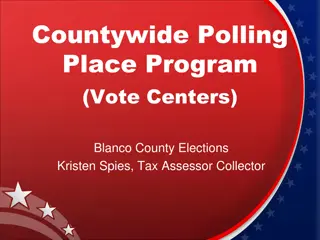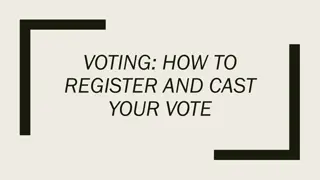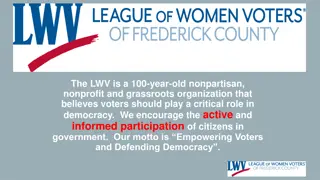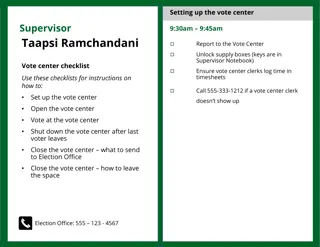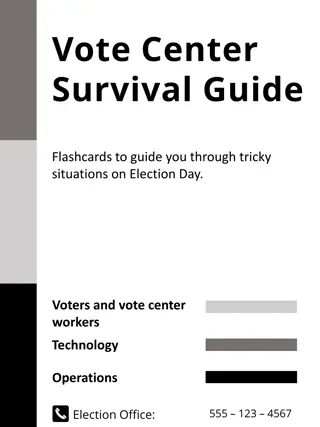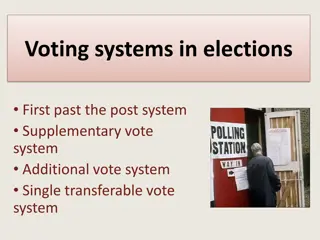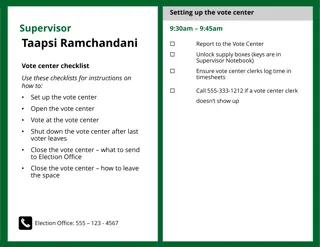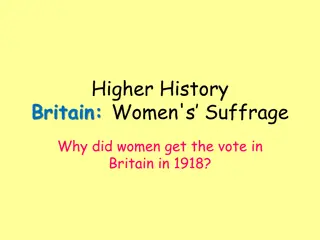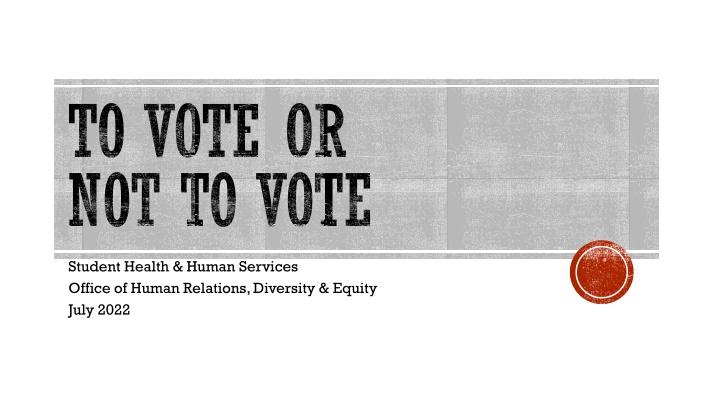
The Evolution of Voting Rights in the U.S.
Delve into the rich history of voting rights in the United States, from the 15th Amendment to modern-day voting accessibility laws. Explore reasons to vote, learn how to register, and reflect on the progress and challenges in ensuring voting rights for all citizens.
Download Presentation

Please find below an Image/Link to download the presentation.
The content on the website is provided AS IS for your information and personal use only. It may not be sold, licensed, or shared on other websites without obtaining consent from the author. If you encounter any issues during the download, it is possible that the publisher has removed the file from their server.
You are allowed to download the files provided on this website for personal or commercial use, subject to the condition that they are used lawfully. All files are the property of their respective owners.
The content on the website is provided AS IS for your information and personal use only. It may not be sold, licensed, or shared on other websites without obtaining consent from the author.
E N D
Presentation Transcript
TO VOTE OR NOT TO VOTE Student Health & Human Services Office of Human Relations, Diversity & Equity July 2022
CHECK IN Would you vote in the next election if you were 18? If you are 18, are you planning on voting?
OBJECTIVES HistoryLearn about the history of voting in the U.S. IdentifyTop 10 reasons to vote LearnHow to get registered to vote
THE HISTORY The 15th Amendment to the U.S. Constitution eliminates racial barriers to voting;however, many states continue practicing voter discrimination. Poll taxes, literacy tests,fraud, and intimidation still prevent many from voting. Native Americans are still denied the right to vote Washington voters amend the State Constitution, giving citizens the power to propose initiatives and referenda; the first statewide initiative is 1914 bans alcohol sales. Voting is controlled by individual state legislatures. Only white men age 21 and older who own land can vote. 1870 1912 1776 1868 1920 1910 The 14th Amendment to the U.S. Constitution grants full citizenship rights,including voting rights, to all men born or naturalized in the United States. The 19th Amendment to the U.S. Constitution is ratified, giving women the right to vote nationwide. Washington voters amend the State Constitution, allowing women to vote and run for office.
THE HISTORY The federal Civil Rights Act is passed to ensure that all men and women age 21 and older, regardless of race, religion, or education, have the right to vote. The 24th Amendment to the U.S. Constitution is ratified, eliminating poll taxes nationwide. Washington State voters pass Initiative 40, repealing the poll tax. Poll taxes are used in many states as a way to discriminate against certain voters. The 26th Amendment to the U.S. Constitution lowers the voting age to 18. 1924: 1965: 1923: 1964: 1971: The Indian Citizenship Act grants Native Americans citizenship and voting rights. The federal Voting Rights Act suspends literacy tests. Registration and voting rights are now federally enforced.
THE HISTORY The federal Voting Rights Act is renewed, permanently banning literacy tests nationwide. Section 203 is added, requiring translated voting materials in areas with large numbers of citizens with limited English skills. After a lengthy U.S. Supreme Court battle, Washington enacts the Top 2 Primary that allows voters to choose any candidate regardless of party preference. About 4 million people are registered to vote in Washington, roughly 68 percent of those eligible. 1975 2008 Today 1984 2009 The federal Voting Accessibility for the Elderly and Handicapped Act requires polling places to be accessible to people with disabilities. Washington becomes the second state in the U.S. (after Oregon) to vote entirely by mail rather than in person at the polls.
10 REASONS TO VOTE To allocate money to your state, county,city Decide how tax money is spent It's your right! Better healthcare Immigration policies Equal rights for all Jobs Education Social security Public safety
THIS IS WHY WE VOTE
TIME TO SHARE What are the top 3 reasons you would vote?
Online:Register here You will need: a California-issued driver license or California identification card number the last four digits of your social security number consent to the use of your DMV-stored digital signature to use California's online voter registration system. HOW CAN YOU GET REGISTERED? If you don't have a California-issued ID or don't want to provide consent for the use of your digital signature, you can still register by mail to vote.
HOW CAN YOU GET REGISTERED? By mail Print and fill out the National Voter Registration Form. Box 6 - ID Number: When you register to vote, you must provide your California driver's license or California identification card number, if you have one. If you do not have a driver's license or ID card, you must provide the last four digits of your Social Security number (SSN). If you do not include this information, you will be required to provide identification when you vote. Box 7 - Choice of Party: California does NOT require that you register with a party to participate in partisan primary elections. However some parties do not allow unaffiliated voters to participate in their party's presidential, local, or county committee primary elections. Box 8 - Race or Ethnic Group: Leave blank. This information is not required. Review the "Who can vote?" section above and check that you're eligible. Sign the form. Send the completed form to your local election official. To register by mail, the form must be postmarked by Monday, October 19, 2020. If you are registering to vote for the first time in your jurisdiction and are mailing this registration application, Federal law requires you to show proof of identification the first time you vote. Proof of identification includes: A current and valid photo identification or A current utility bill, bank statement, government check, paycheck or government document that shows your name and address. More information here. Mail to:Dean Logan, Registrar - Recorder/County Clerk P.O. Box 1024 Norwalk, CA 90651-1024
HOW TO GET REGISTERED Same Day Registration
If you could allow everyone living in the United States to vote, would you? Why or Why not? TIME TO SHARE
Did this presentation change your mind about voting? Why or Why not? CHECKOUT
TEACHER FEEDBACK
HUMAN RELATIONS, DIVERSITY & EQUITY

